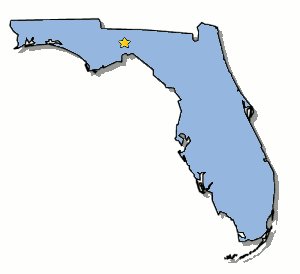Florida Migration History 1850-2022
 Other state maps: California, Florida, Illinois, Texas, New York, Alabama, Arizona, Colorado, Utah, Virginia, Washington, all other states
Other state maps: California, Florida, Illinois, Texas, New York, Alabama, Arizona, Colorado, Utah, Virginia, Washington, all other states
by James Gregory
More than any other southern state, Florida has consistantly attracted newcomers. Today only about one third of the population claims a Florida birthplace; two thirds are from somewhere else, many from Cuba and Latin America but really from every state and most nations. Migration to Florida is an old story, In the late 1800s, Florida grew rapidly as whites from neighborhing states moved south looking for land to farm. The great citrus rush and land boom started in the early decades of the 20th century and accelerated in the 1920s, attracting northerners as well as southerners. Florida's population doubled between 1920 and 1940 and then doubled again by 1960, again by 1980, and once more by 2010. Snowbird migration made New York, Pennsylvania, and Ohio leading contributors after 1960. Cubans and other people from the Caribbean had been part of the population throughout the decades, but the Cuban diaspora that began in the 1960s has made an enormous impact. Since 2000 Cubans rank second only to New Yorkers among those with out-of-state birthplaces.
Notice the changing composition of the Latinx population in recent decades in the vizualization tool below. This visualization is hosted by Tableau Public and may take a few seconds to respond. If slow, refresh the page. Click here for other state migration histories
Move between four visualizations with tabs below
Note on data issues: The 1850 and 1860 censuses counted only "free persons" so it was not until 1870 that reliable data on African Americans became available. Native Americans were not routinely included in decennial censuses until 1900. Birth state information is missing for about 5% of US-born persons in 1970 and about 2% in 1960. The missing are designated "United States,ns" in the charts.
Source: U.S. Census data from the Minnesota Population Center's IPUMS USA: Steven Ruggles, Katie Genadek, Ronald Goeken, Josiah Grover, and Matthew Sobek. Integrated Public Use Microdata Series: Version 6.0 [Machine-readable database]. Minneapolis: University of Minnesota, 2015, the following samples: 1850 1%, 1860 1%, 1870 1%, 1880 1% 1900 1%, 1910 1%, 1920 1%, 1930 1%, 1940 1%, 1950 1%, 1960 5%, 1970 1% State FM1, 1980 5% State, 1990 5% State, 2000 1%, 2010 ACS, 2022 ACS.
Maps, data development, calculations: James Gregory.

 Other state maps:
Other state maps: